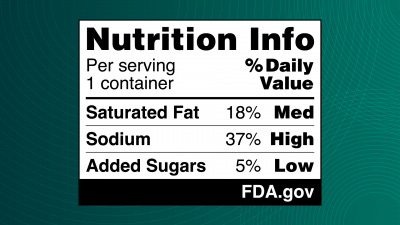Why FDA’s Front-of-Package Nutrition Labels Are a Good Idea
Overwhelmed by Nutrition Labels? The FDA’s Plan Could Finally Simplify Things
With all the modern commodities of 2025 making healthy food choices isn’t always easy. With busy schedules and overwhelming options, consumers often don’t have time to analyze nutrition labels buried on the back of packages. The FDA’s proposed front-of-package (FOP) nutrition labels aim to change that by providing clear, easy-to-read information on key nutrients—like saturated fat, sodium, and added sugars—right on the front of food packaging. This initiative makes sense as it empowers shoppers to make healthier choices in seconds, without slowing down their day.
What’s Changing?
The FDA proposes a labeling system that categorizes saturated fat, sodium, and added sugars as "Low," "Medium," or "High," making it easier for consumers to assess a product's nutritional quality at a glance. While calorie information won’t be required, manufacturers may display it voluntarily. The initiative is part of a broader effort to address chronic diseases like obesity and heart disease. Public feedback on the proposal is being accepted until May 16, 2025. More details here.
Learning from Global Success
Many countries have already adopted FOP labeling with proven success, and the U.S. has an opportunity to follow their lead and implement the best practices.
Mexico: Introduced bold black warning labels on products high in sugar, calories, and saturated fats. Studies show a decrease in the purchase of high-sugar beverages and increased consumer awareness.
Chile: Implemented strict FOP warning labels and marketing restrictions on unhealthy products. As a result, food companies reformulated products to reduce sugar and sodium content.
United Kingdom: Uses a traffic light system—green, amber, and red—to indicate the levels of fat, sugar, and salt in foods. This simple visual approach helps consumers make informed choices at a glance.
Canada: Recently introduced FOP labels with clear symbols to flag foods high in saturated fat, sugar, and sodium, making it easier for shoppers to identify healthier options.
Brazil: Enforced mandatory front-labeling with clear warnings about excessive ingredients, alongside public health campaigns to educate consumers on nutrition.
Why the U.S. Should Follow Suit
By adopting elements from successful global models, the U.S. can:
Encourage Industry Reform: Companies will be more likely to reduce unhealthy ingredients to avoid warning labels.
Promote Public Health: Transparent labeling can help combat rising obesity and chronic disease rates.
Key Benefits of FOP Labels
Simplify Healthy Choices: Clear, prominent labeling allows consumers to make informed decisions in seconds.
Greater Transparency: Food brands must disclose essential nutrition facts upfront.
Healthier Choices: Consumers are nudged toward better dietary decisions with simple visual cues.
Increase Awareness: Educating the public alongside labeling efforts will further empower consumers to make healthier choices.
Potential Challenges
Despite the benefits, the food industry may resist the change due to concerns about sales and product perception. Critics also argue that omitting calorie counts could disadvantage those monitoring their intake, but the focus on key nutrients addresses more urgent health risks.
What’s Next?
With the U.S. facing an obesity epidemic and rising healthcare costs, front-of-package nutrition labels offer a practical way to support healthier eating habits. The FDA is currently gathering feedback on the proposed FOP labeling rule. Consumers, healthcare professionals, and industry stakeholders can submit their comments electronically at www.regulations.gov by May 16, 2025.
To provide feedback, you can write comments and send to:
Dockets Management Staff (HFA-305)
Food and Drug Administration
5630 Fishers Lane, Rm. 1061
Rockville, MD 20852
Include the docket number FDA-2024-N-2910 and the title “Food Labeling: Front-of-Package Nutrition Information.”
If approved, these labels could soon become a familiar sight in grocery stores across the U.S., helping shoppers make smarter choices effortlessly.
What’s your take on the FDA’s new labeling proposal? Let’s discuss below!


